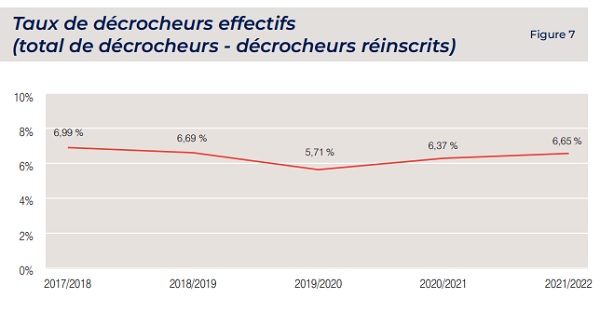
On Friday 16 June 2023, Luxembourg's Ministry of National Education, Children and Youth published the new edition of a report on school dropouts and young inactive people in Luxembourg, which focuses on school dropout between the years 2017/2018 and 2021/2022.
According to the ministry, the fight against school dropout is one of their priorities. To achieve this, it is important to clearly understand the phenomenon, to identify the groups of students most affected and to understand the reasons that lead a young person to leave school prematurely.
The report focuses on pupils who left the Luxembourg school system during, or at the end of, the school year without a diploma or certification. After a rebound in 2020/2021 compared to 2019/2020, the 2021/2022 rate is down compared to the previous year. While in 2020/2021 the dropout rate stood at 8.38%, it dropped to 8.19% in 2021/2022. The 2019/2020 school year was exceptional given the impact of the Coronavirus pandemic.
Dropout rates:
- 2017/2018: 8.37%
- 2018/2019: 7.95%
- 2019/2020: 7.05%
- 2020/2021: 8.38%
- 2021/2022: 8.19%
“Our ambition is to offer every youngster a chance to qualify and the best possible future prospects. For this reason, the fight against dropping out remains a priority that requires the collective effort of our schools, teachers, parents and all the specialised services that support students," said the Minister of National Education, Childhood and Youth, Claude Meisch.
According to the ministry, Luxembourg has thus achieved the objective set by the European Union as part of its “Europe 2020” strategy by being below the 10% threshold for a number of years. Similarly, Luxembourg has achieved the target set by the Member States for the year 2030, namely to have a dropout rate of less than 9%. The rate confirms the validity of the measures taken by the Ministry of National Education, Childhood and Youth at different levels: diversification of the school offer, introduction of socio-educational services in high schools, adaptation of registration deadlines for vocational training, etc.
Of the 1,767 dropouts for the 2021/2022 school year, 316 subsequently re-enrolled. If one disregards the dropouts who re-enrolled the following school year, the rate of effective dropouts is 6.65% in 2021/2022.
Effective dropout rate (total dropouts - dropouts re-enrolled):
- 2017/2018: 6.99%
- 2018/2019: 6.69%
- 2019/2020: 5.71%
- 2020/2021: 6.37%
- 2021/2022: 6.65%
Support young people to re-enrol
Dropping out of school may just be a hiccup, with no lasting impact on the young person. The main thing is that (s)he reconnects at some point with training that will lead him/her to a certification or a diploma. The services of the ministry in charge of monitoring dropouts encourage young people to reconnect with school.
The re-enrolment rate was 17.9% as of 15 November 2021 and 25.3% as of 31 December 2021.
The re-registration rate can be increased by extending the registration period. It is important that young people can re-enroll during the months following the start of the school year without compromising their learning. Thus, in agreement with the professional chambers, the deadline for concluding an apprenticeship contract had been extended until 30 November in 2021.
Risk groups
Certain groups of students are at greater risk of dropping out:
- students who have accumulated an academic delay of at least two years: this is the case for 61.5% of dropouts;
- boys more than girls: boys represent more or less 60% of dropouts every year;
- students in the 9th and 10th years of secondary education: in 2021/2022, 47% of dropouts come from these classes. Although this rate has dropped compared to previous years, these classes constitute pivotal moments in the choice of the training path or the orientation of studies and thus particular challenges in the fight against school dropout.
Preventing the dropout of students in transition to vocational training
Students who wish to do vocational training in the concurrent system are faced with specific challenges: they must both enrol in a school that offers the desired training and conclude an apprenticeship contract with an employer.
Since 2020, measures have been put in place to support students in difficulty, in particular the possibility of enrolling in a school and taking lessons while waiting to find a trainer/boss, with the support of the socio-pedagogical teams.
Since 2020, measures have been put in place to support students in difficulty, in particular the possibility of enrolling in a school and taking lessons while waiting to find a trainer/boss, with the support of the socio-pedagogical teams of the secondary schools, national continuing vocational training centers (CNFPC) and agents from local branches of the National Youth Service (SNJ). Even if it is not possible to quantify the impact of these efforts, it is clear that they have contributed to the dropout rate in 2021/2022.
1,587 dropouts contacted by the SNJ
The local branches of the National Youth Service (SNJ) carry out individual follow-up of dropouts. In 2021/2022, they contacted and offered their support to 1,587 young people.
SNJ workshops increasingly in demand
The SNJ mainly offers alternatives to inactivity, such as voluntary services, workshops and discovery courses.
The workshops are becoming more and more popular with young people and are more and more frequented (+9.5% compared to the previous year). The highest attendance was during the months of February to July, when most students drop out of school and seek alternatives.
The number of young people taking part in a voluntary service or a discovery course is down slightly compared to the previous year.








